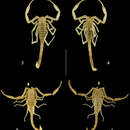en
names in breadcrumbs


The scorpion family Pseudochactidae was created in 1988 to contain the remarkable newly-discovered "living fossil" species Pseudochactas ovchinnikovi Gromov, 1998 from central Asia.Since then, two more species: Troglokhammouanus steineri Lourenço, 2007 from Laos, and Vietbocap canhi Lourenço and Pham 2010 from Viet Nam, both cave dwellers, have been discovered and added to Pseudochactidae, making a total of three known species in this family.
Although generally considered a basal scorpion lineage, the relation of this family to the rest of the scorpions is still debated; sister relationships to the Chaerilidae and the Buthidae have been suggested (Lourenço and Pham 2010).
One of the most remarkable scorpions described during the last 30 years is Pseudochactas ovchinnikovi Gromov, 1998, discovered in an isolated mountainous region of southeastern Uzbekistan and southwestern Tajikistan in Central Asia. Although this scorpion shares some features with buthid and nonbuthid scorpions, it is remarkable because it displays a number of characters unique among recent (extant) scorpions, including a distinct trichobothrial pattern. This led Gromov (1998) to create a new monotypic family, the Pseudochactidae Gromov, 1998.
Subsequently, authors have not reached a consensus regarding the phylogenetic position of this enigmatic scorpion. Based on its peculiar trichobothrial pattern, Fet (2000) suggested a relationship to the most plesiomorphic Buthidae C. L. Koch, 1837 or to Chaerilidae Pocock, 1893. Lourenço (2000) placed Pseudochactas in a new superfamily, Chaeriloidea Pocock, 1893, implying that he considered it to be the sister group of Chaerilus. Although there is widespread agreement that Pseudochactas is basal within recent scorpions, its precise phylogenetic position remains a matter of debate (Fet et al. 2004). In an exhaustive study of Pseudochactas ovchinnikovi, Prendini et al. (2006) concluded that the most plausible position for this ‘living fossil’ would be as the sister-group of Buthidae.
Shortly after these publications, a second genus and species belonging to the family Pseudochactidae, Troglokhammouanus steineri Lourenço, 2007, was described from karst caves in Laos (Lourenço 2007a). This new element of the Pseudochactidae reopened the question about the origins and affinities of this family and led to new biogeographical interpretations (Lourenço 2007a). The precise morphology of this new pseudochactid scorpion was also complemented by SEM studies and a further comparison with elements of the family Chaerilidae (Lourenço 2007b).
Since the description of Troglokhammouanus steineri (Lourenço 2007a, b), no new insights have been published on this subject.
While prospecting scorpions in a karst cave system in Vietnam, Dinh-Sac Pham of the Institute of Ecology and Biological Resources (IEBR), Vietnam Academy of Science and Technology (VAST) was able to collect several specimens of a new pseudochactid scorpion. These were described as a new genus and species, Vietbocap canhi sp. n. (Lourenço and Pham 2010). In this note Lourenço and Pham do not propose new phylogenetic or biogeographical considerations, since these have already been largely discussed by Lourenço (2007a). It is important, however, to notice that the new Vietnamese pseudochactid comes from caves belonging to the same karst system as those in which Troglokhammouanus steineri was found in Laos. This could suggest that this region of Southeast Asia may represent a refuge or an endemic centre for elements of this family. Finally, as suggested by Prendini et al. (2006), the discovery of Pseudochactas ovchinnikovi could represent the most remarkable scorpion discovery during the last (20th) century. In this same vein, the discoveries of two new genera and species of pseudochactids in Laos and Vietnam are far from negligible.
Fet V (2000) Family Pseudochactidae Gromov, 1998. In: Fet V, Sissom WD, Lowe G, Braunwalder ME. Catalog of the Scorpions of the World (1758–1998), New York Entomological Society, 426.
Fet V, Soleglad ME, Gromov AV (2004) The platypus of a scorpion: the genus Pseudochactas Gromov, 1998 (Scorpiones: Pseudochactidae). Euscorpius 17:61-68.
Lourenço WR (2000) Panbiogéographie, les familles des scorpions et leur répartition géographique. Biogeographica 76:21-39.
Lourenço WR (2007a) First record of the family Pseudochactidae Gromov (Chelicerata, Scorpiones) from Laos and new biogeographic evidence of a Pangaean palaeodistribution. C. R. Biologies 330:770-777.
Lourenço WR (2007b) Complements to the morphology of Troglokhammouanus steineri Lourenço, 2007 (Scorpiones: Pseudochactidae) based on scanning electron microscopy. Euscorpius 59:1-6.
Gromov AV (1998) A new family, genus and species of scorpions (Arachnida, Scorpiones) from southern Central Asia. Zool. Zhurnal, 77: 1003-1008 (in Russian, English summary, English translation: Russ. J. Zool., 2 (1998): 409–413).
The Pseudochactidae are a scorpion family. They are predominantly found in caves. [1]